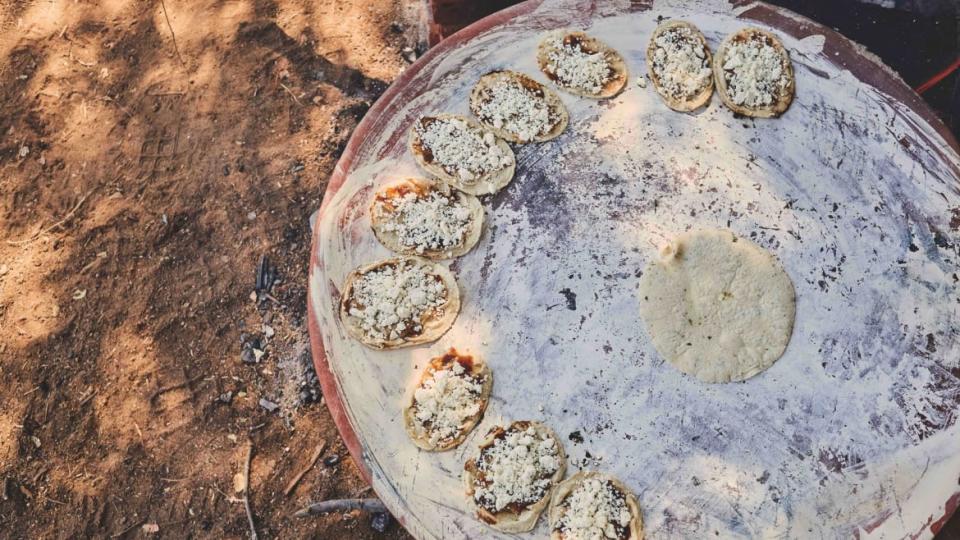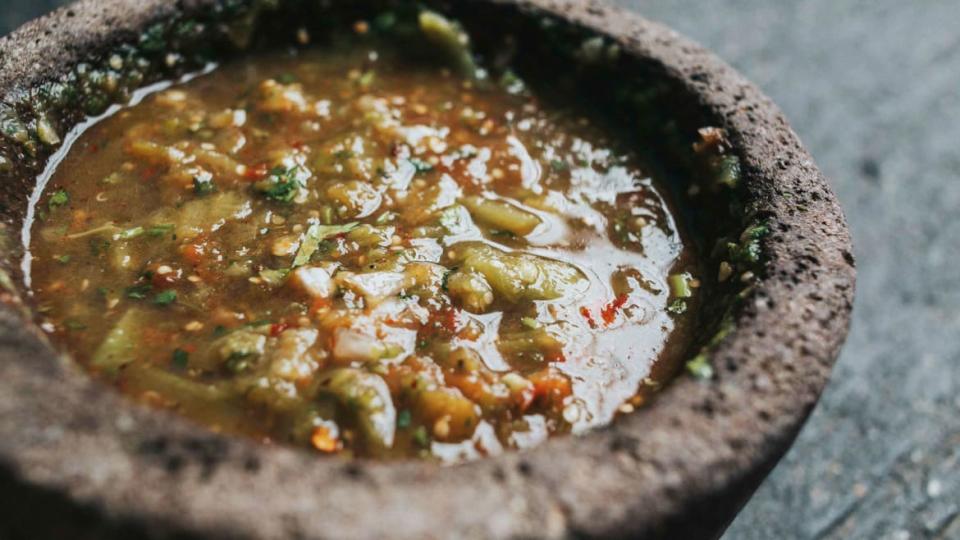Crazy About Tacos? Then You’ll Love Oaxacan Memelas

Alejandro Ruiz learned how to make memelas when he was just six years old. The handheld, oval-shaped “cornmeal cake,” which is usually topped with black bean paste, salsa and cheese, is a staple of his hometown La Raya de Zimatlán in Oaxaca, Mexico.
“Memela is a traditional breakfast in Oaxaca in almost every single home,” says Ruiz, chef and owner of six restaurants, including Casa Oaxaca El Restaurante and Oaxacalifornia. “This is one of the dishes you will have at least once a week.”
Bake These Sesame & Chocolate Chunk Cookies Right Now
Make the Meatball Sliders That Conquered New York
Though he says that the word memela is unique to Oaxaca, the dish is quite similar to those found in other parts of Mexico, including sopes and huaraches, and it showcases a few of the ingredients that are important to Mexican culture—namely beans, chiles and corn.
“Corn is one of our basic ingredients in Oaxaca,” says Ruiz. “I was born and I was raised in a small village, and my parents were farmers. So we always had corn at home. And that is the basic [ingredient] for making a tortilla and, of course, a memela.”

Ruiz’s recipe for memelas was an obvious choice to include in his recently released cookbook, The Food of Oaxaca, which features a variety of recipes, from tamales to Mexican chocolate mousse. The collection of recipes only serves to strengthen his reputation as an ambassador of Oaxacan food, which he’s long served in his Oaxaca and Mexico City restaurants. “Our traditional food is based on corn, beans, pumpkins, herbs and chiles,” says Ruiz. “I think that [gives it] a big relevance in our culture.”
The memelas, in particular, are a significant hallmark of Oaxacan flavor and history for Ruiz. It’s a recipe that he now also passes on to children who take his cooking workshops.
The Food of Oaxaca features what he calls a “basic” recipe that builds on the quintessential masa base with pork asiento (unrefined lard), a refried bean paste made with the pungent Mexican herb epazote and avocado leaves, salsa made with a local chile pepper and deliciously tangy queso fresco.
While Ruiz loves the rich flavor of his basic memela recipe, he says that it’s also incredibly versatile—think of it as an open-face tortilla. “More and more chefs from all over the world are trying to learn how to make a perfect tortilla and memela belongs to this group,” he says.
Ready to try your hand at making memelas? Here are Ruiz’s best tips for making this Oaxacan classic.
THE MASA BASE
Preparing the corn meal base is the most important step in making memelas. Because they’re eaten without utensils, you’ll want to make sure they’re thick enough to hold together when picked up—at least twice as thick as a tortilla—and that you form a lip around the edge to hold in all the toppings. Ruiz uses only three ingredients for this: a quality corn flour or masa, like the Maseca brand, water and pork asiento (unrefined pork lard).
The masa and water are mixed until the dough holds together and the flour no longer sticks to your fingers. Then, you form it into balls of about 20 grams each before shaping them into ovals with a tortilla press or rolling pin. If using a tortilla press, Ruiz recommends using two pieces of plastic wrap on each side of the ball of dough, so it’s easier to separate from the press (plastic baggies or clean, repurposed grocery bags work well).
The masa ovals are then cooked for about 30 seconds on each side until they look dry, but aren’t yet cracking. Then, while it’s still warm, you’ll pinch a lip around the outside of the memela to hold in the toppings before spreading a bit of asiento on top for a touch of flavor and topping-holding power. “Asiento is the bottom of the lard after frying pork rinds or frying carnitas or frying ribs,” says Ruiz. “It is only used in Oaxaca. If you don’t put asiento on a memela it’s like when you kiss somebody without love.”
However, Ruiz adds that if you don’t have asiento, you can use any lard or oil in its place: “Believe me, if you make an amazing black bean paste you don’t need lard.”
THE BEAN PASTE
A traditional memela topping, Ruiz’s black bean paste combines onion, garlic, salt, lard, chile, epazote (a strongly flavored herb) and avocado leaves. As Ruiz notes in his recipe, it can be made without the epazote and avocado leaves, but the ingredients do add a distinctive flavor, so try to source them if possible.
One of the most important things to keep in mind is that, first and foremost, “it has to be black beans,” says Ruiz. “Secondly, they have to be cooked very well done and feel very soft, and when you mash them, they have to be mashed with the juice or the broth [from cooking].”
Once the beans are cooked, you’ll flavor some lard by deeply caramelizing and even slightly burning onion, garlic and epazote. “What you’re going to do is blend those beans with a roasted or fried avocado leaf until very fine,” says Ruiz. “Then strain and fry [the paste] in lard or oil where you had previously burned the onion.”
Of course, memelas, like sopes and huaraches, can be topped with just about anything, from pork to chicken to chapulines (grasshoppers) to huitlacoche (corn smut fungus traditional to Mexican cuisine). “The [recipe] that I have in the book is like the basic memela you can have, but you can do any topping,” he says. At Casa Oaxaca Reforma, “we have a memela and we are putting roasted suckling pig on top and that’s delicious.”
THE CHEESE & SALSA
While you could top your memela with any cheese and salsa you’d like, Ruiz recommends trying one ultra-traditional Oaxacan combination: queso fresco and chile de agua salsa.

“Chile de agua is an endemic chile of Oaxaca, and is a very important ingredient for our food in the city,” says Ruiz. “The flavor here is intense and spicy, and kind of lemony. Somehow it smells and tastes like lemongrass. It is very, very interesting and very, very good.”
While it’s a simple recipe that only takes about 20 minutes to make, he does have a couple of tips to get the flavor just right, including roasting the chiles and tomatoes directly on a flame. “This is very important because one of the traditional techniques and flavors of Mexican traditional food is this smokiness in the flavor,” says Ruiz. Then, you’ll combine all the ingredients in a bowl or molcajete (mortar and pestle) and mash them, starting with the garlic and salt (“that way you get the garlic flavor in the whole sauce when you make it”) and following with the peppers and tomatoes.
Ruiz also likes to add some raw onion, cilantro and avocado at the end. You can also try out other pepper and tomato combinations if you can’t find chile de agua. “There can be variations,” he says. “Usually, when you go to a memelas stand, they offer you two or three kinds of different salsas being prepared in a molcajete. You can use morita chiles and tomatillo or you can use chile de agua—any kind of salsa, you know?”
Memelas
*This recipe makes 35 memelas
INGREDIENTS
2 pounds Corn masa
.75 cup Pork asiento (you may substitute lard, although the flavor will be a little different)
1 cup Refried bean paste*
.75 cup Queso fresco or feta cheese, crumbled
Chile de agua salsa**
DIRECTIONS
Preheat a comal, griddle, or a well-seasoned cast iron skillet over medium heat. You will also need a tortilla press (or a rolling pin) and two pieces of plastic wrap cut into squares or circles that are large enough to extend at least two inches beyond the diameter of the press.
Take enough masa to roll into a small ball, approximately one-and-a-half inches in diameter, then reshape the masa into a log about five inches long, with the ends slightly tapered.
To form the memela, place the log between the two plastic sheets, and put it in the press. Close the press, and flatten the masa to about an eighth-of-an-inch. In order to give the memelas an even thickness, turn the plastic sheets around 180° and exert pressure again. You should end up with a five-and-a-half inch by three inch oval.
Place the memela on the comal or pan, and cook for about 30 seconds. Turn it over, and cook for another 20 seconds. Flip the memela over once more and cook for another 15 seconds. The memela is done when the masa looks dry but still plump, not cracked.
Remove it from the comal or pan, and while still hot, use your thumb and index finger to pinch around the border of the memela, forming a lip.
Once all the memelas are formed, spread onto each one a teaspoon of pork asiento and a good amount of refried bean paste. Sprinkle with the cheese, and return the memelas to the comal or pan to lightly toast the bottoms. Serve warm with while de agua salsa or any other salsa of your choice.
Bean Paste*
INGREDIENTS
1 Onion, chopped into wedges
2 Garlic cloves, smashed
1 Epazote stem, whole
.25 cup Lard
1 Chile de árbol, slightly charred
3 Hojas de aguacate, slightly charred
Salt, as desired
DIRECTIONS
To make the bean paste, cook 2 pounds of dried black beans and reserve 1 cup of cooking liquid. Then, fry the onion, garlic and epazote in a pan with the lard. Once the ingredients begin to caramelize and burn slightly at the edges, remove from the heat and discard all but the flavored lard, reserving it in the pan.
Transfer the beans to a blender and puree with their liquid, the chile de árbol and the hojas de aguacate. Add water as needed in order to blend completely and arrive at a smooth paste.
Fry the black bean puree in the pan with the flavored lard, stirring occasionally to avoid burning. The water will slowly evaporate and the beans will dry into a paste. You will know it’s done when a spoon dragged across the bottom of the pan leaves a trail. Taste for salt and adjust as desired.
Chile de Agua Salsa**
INGREDIENTS
1 Chile de agua, stemmed
2 Tomatoes
1 small Garlic clove or half a medium-sized clove
.5 Tbsp Salt
DIRECTIONS
Set a comal, pan or cast-iron skillet over high heat. Roast the chiles and the tomatoes, turning them over occasionally until their skin is partly charred and they are soft to the touch. The chile will be done first. It’ll take about 5 to 10 minutes for the tomatoes.
Rub the garlic along the walls of a molcajete, discarding the rest. If you are using a mortar and pestle, pound only half the raw garlic clove into a paste. Then add the chile, pound some more, and follow with the tomatoes. You don’t want to completely disintegrate the chile and tomatoes, you are looking for a chunky consistency. Add the salt and mix well.
Excerpted from THE FOOD OF OAXACA: Recipes and Stories from Mexico’s Culinary Capital by Alejandro Ruiz and Carla Altesor. English Translation Copyright © 2020 by Alfred A. Knopf. Excerpted by permission of Alfred A. Knopf, a division of Penguin Random House LLC. All rights reserved. No part of this excerpt may be reproduced or reprinted without permission in writing from the publisher.
Get our top stories in your inbox every day. Sign up now!
Daily Beast Membership: Beast Inside goes deeper on the stories that matter to you. Learn more.

